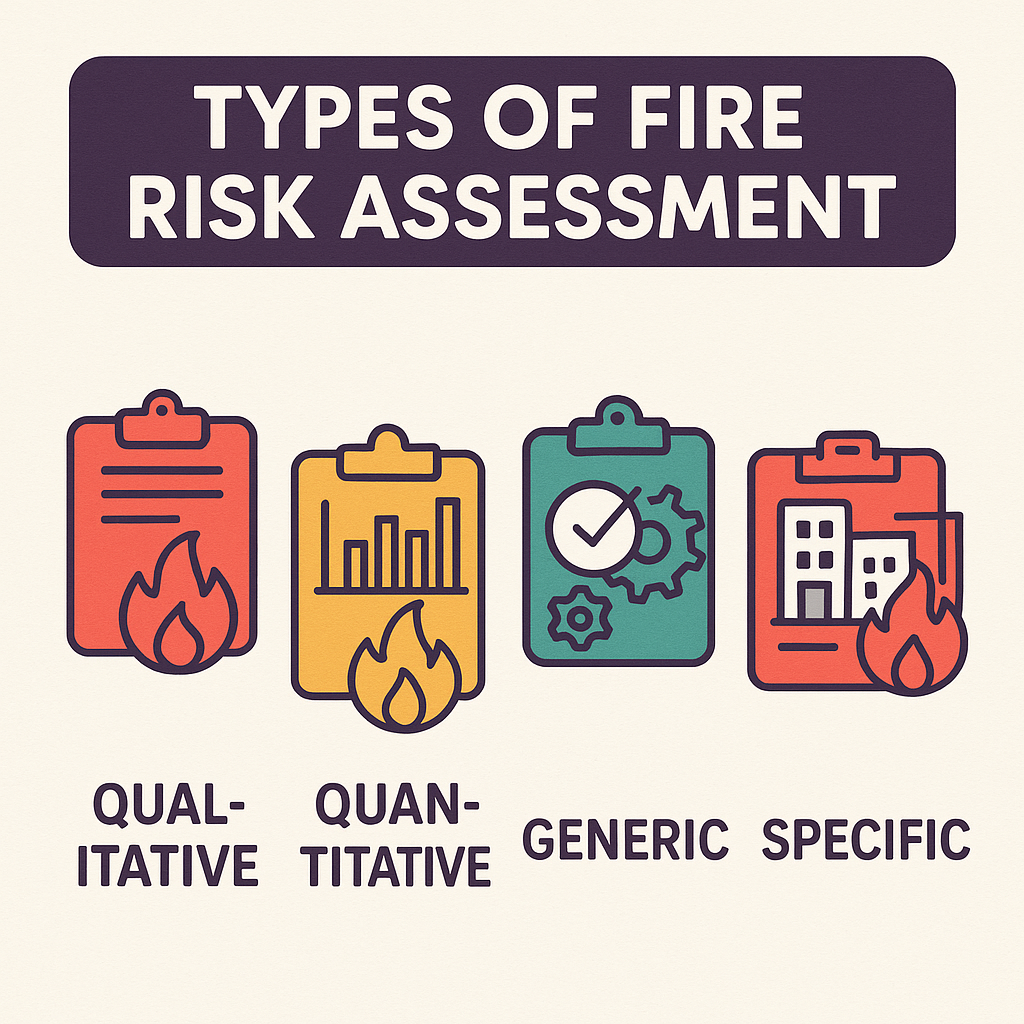Fire risk assessments are a crucial part of maintaining a safe environment for any business or property. In the UK, different types of fire risk assessments are carried out depending on the building, its usage, and occupancy.

The main types include:
- Qualitative Fire Risk Assessment
- Quantitative Fire Risk Assessment
- Generic Fire Risk Assessment
- Specific Fire Risk Assessment
- Fire Strategy Report
- Specialist Fire Risk Assessments
Qualitative Fire Risk Assessment
This is the most common type and involves identifying fire hazards, people at risk, evaluating existing fire safety measures, and deciding if improvements are needed. It’s based on observation and professional judgment without heavy calculations.
Quantitative Fire Risk Assessment
A more technical approach that uses numerical values to assess the likelihood of a fire and its potential consequences. This type is often used in complex, high-risk environments such as chemical plants or large industrial sites.
Generic Fire Risk Assessment
A generic fire risk assessment is a standardized evaluation designed to identify and mitigate fire hazards in common types of premises or situations. Unlike site-specific assessments, it provides a general framework applicable to multiple buildings with similar layouts, operations, or fire risks. This type of assessment is commonly used for low-risk environments such as small offices, retail shops, or residential blocks.
The main objective is to ensure that basic fire safety measures are in place, such as clear escape routes, working smoke alarms, and accessible fire extinguishers. It typically includes hazard identification, evaluation of existing precautions, and general recommendations for improvement. While cost-effective and time-saving, a generic assessment may not fully address unique risks of a specific location.
Therefore, businesses must periodically review and adapt the assessment to reflect any changes in the environment or operations. In short, a generic fire risk assessment is a practical starting point for ensuring fire safety compliance.
Specific Fire Risk Assessment
A specific fire risk assessment is tailored to a particular building, process, or activity that presents unique fire hazards. Unlike generic assessments, it considers detailed factors such as the building’s structure, occupancy, materials used, and operational practices. This type of assessment is essential for complex or high-risk environments like factories, hospitals, or large commercial premises.
It involves a thorough analysis of ignition sources, potential fuel, evacuation routes, and existing fire control measures. The goal is to identify specific risks and recommend targeted actions to minimize them. Regular updates are crucial, especially after changes in layout, staff, or equipment. A specific fire risk assessment ensures a higher level of safety and legal compliance by addressing risks unique to the premises.
Fire Strategy Report
Often required for new buildings or major renovations. It outlines the fire safety design, escape routes, fire protection systems, and how the building will meet regulations such as the Building Regulations 2010.
Type 1-4 Fire Risk Assessments (for residential buildings)
Type 1: Basic non-destructive assessment of communal areas.
Type 2: Includes some destructive investigation (checking behind walls, etc.) to assess fire compartmentation.
Type 3: More comprehensive, including individual flats as well as communal areas (non-destructive).
Type 4: Fully intrusive, assessing both flats and communal areas with destructive inspection — usually for higher-risk properties.
Specialist Fire Risk Assessments
These are tailored to specific environments like care homes, hospitals, factories, or heritage sites, where unique risks are present.
Why Choose the Right Type?
Choosing the correct type of fire risk assessment is vital to ensuring compliance with the Regulatory Reform (Fire Safety) Order 2005, protecting lives, and safeguarding property.
At Property Safety Ltd, we can advise you on the right type of fire risk assessment for your premises and ensure a fully compliant, thorough inspection.
